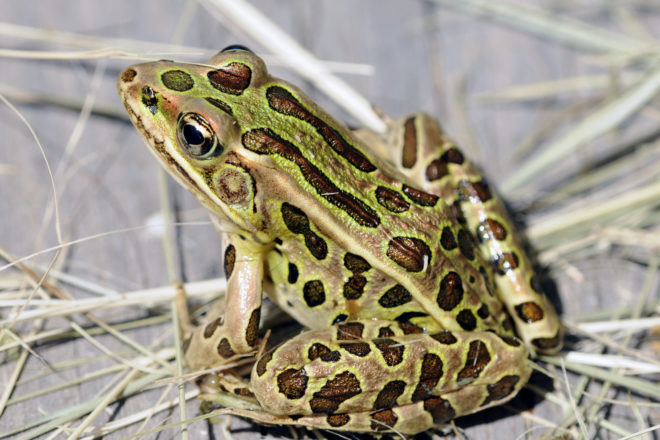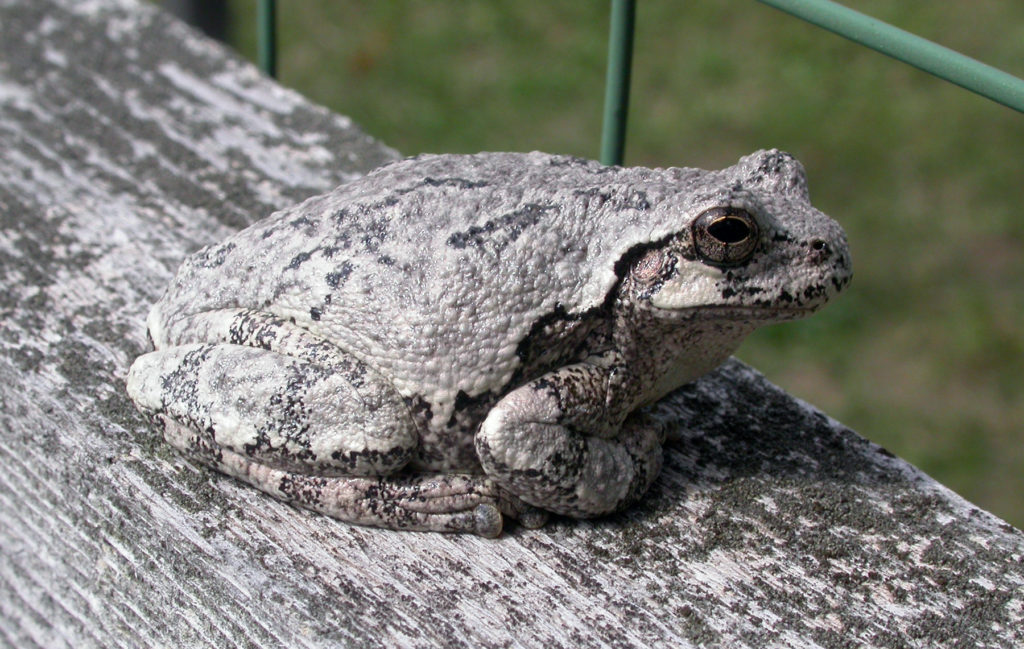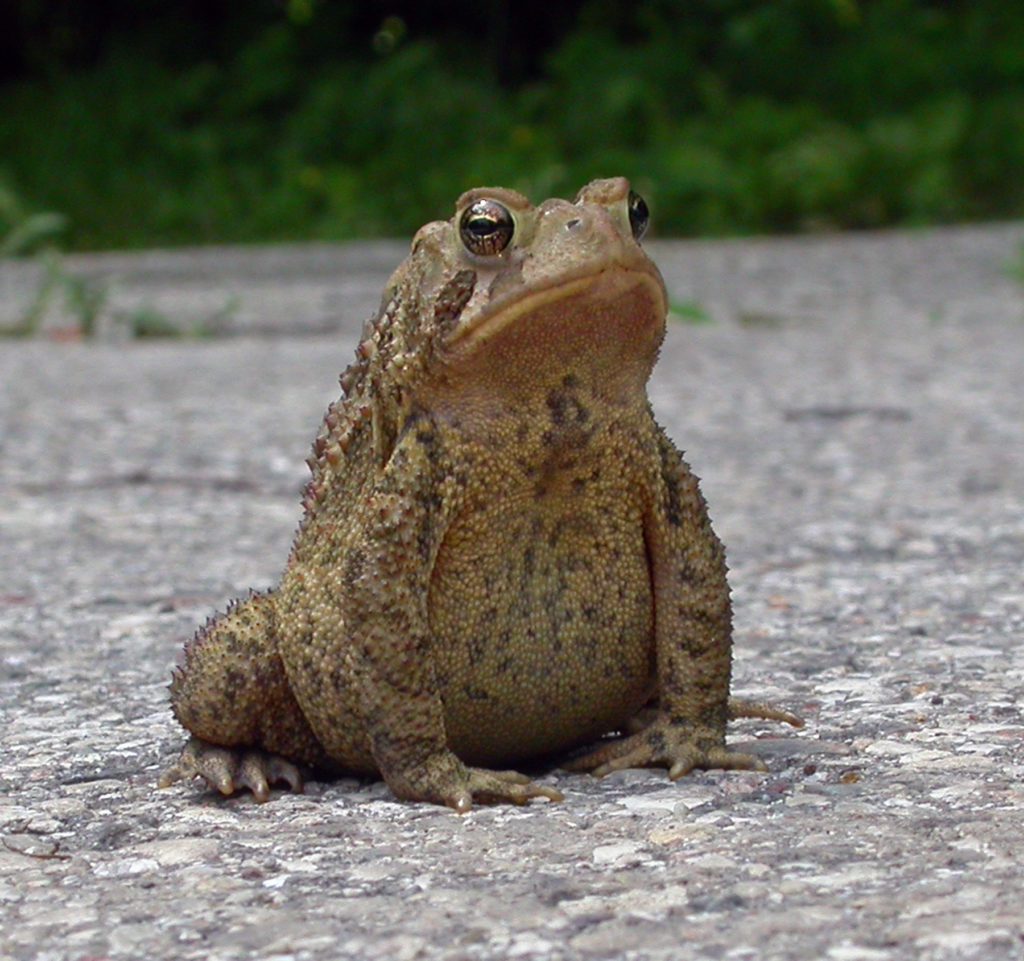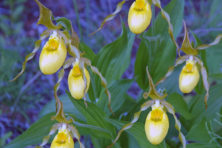Door to Nature: Native Amphibians
- Share
- Tweet
- Pin
- Share

How little we know about reptiles and amphibians. Take, for example, a favorite entry in my journal dating back to the third week of August in 1970. A group of hikers and I were walking along the western portion of Deerlick Trail at The Ridges Sanctuary when suddenly a very strange, high-pitched squeal began no more than 25 feet away. None of us knew what was making that sound.
It turned out that a large garter snake had captured a medium-sized leopard frog in its jaws, hind feet first, causing the frog to call forth with its frenzied death scream. Later, I learned that this is the only call herpetologists are aware of that frogs and toads make with their mouth open.

This gray tree frog’s color makes it blend in with the well-worn wooden fence.
I knelt down just inches away from the drama for a better look. The snake paid little attention to me until I gently nudged the frog’s body. My first impulse had been to free the imprisoned frog from the grip of the snake, but my better judgment sided with the snake. They too need food, and here was ecology, natural selection, survival of the fittest, and balance of nature all unfolding vividly before our eyes.
The second I touched the frog’s body the snake’s tail extended upward and quivered, absolutely vibrated in warning against the grasses and twigs. Then it slowly raised its head nearly a foot above the ground and, majestic in its movements, retreated with the frog into the higher vegetation.
After beginning my work at the sanctuary in June of 1964, I observed what I thought were normal leopard frog numbers for the following seven or eight years. Late August found the wet margins of the swales so abundant with these spotted frogs that one had to be careful to not step on them, or so it appeared. Never in the following years, roughly 45, have I experienced leopard frog populations there at those high numbers.
Possible reasons for the frightening disappearance and reduction of so many species of frogs and toads worldwide have included: loss of habitat, fragmentation of habitat, over-exploitation by people, the spread of competing exotic species and human interference such as pollution, climate change and increase in UV-B radiation which weakens the frogs’ and toads’ immune systems. One biologist summed up the situation by simply stating they are disappearing due to humans’ insensitivity to Earth’s environment.
The study of some frogs, for example, is a fascinating hands-on research project. Many are colorful creatures to photograph and write about. When one or more species suddenly become threatened or endangered, the public soon learns about it. Unfortunately, such is not the case with the extinction of about 17,000 species of plants, animals and insects occurring annually as a direct result of the tropical forest destruction in Central and South America.
One can only wonder in dismay at how many species became extinct in North America in the past 100-plus years as a result of the “slaughter” of most of the old-growth forests along with the filling in of millions of acres of prime wetlands.
There are four wetlands in the county containing small ponds that I like to visit fairly regularly related to my interest in dragonflies and butterflies, and I’m happy to report that every one of them has fair populations of leopard frogs, wood frogs and American toads. At one of them, my friend Nick and I enjoyed finding the largest leopard frog and American toad either of us has ever seen, and that’s a very promising sign.
What made the frog so special was that, rather than the usually predominantly green color, this one was quite bronze-colored, and some of its irregular dark spots were rimmed with bright green. What a gorgeous creature. It looked downright too heavy to jump, but as I approached it for photographs it displayed its leaping ability – easily five feet or more!

An American toad appears fearless as it sits on our driveway.
Three amphibians that have been considerably down in numbers at our place over the past few years have been the American toad and both gray tree frog and Cope’s gray tree frog. I’m hoping the culprit in their case had been the serious droughts in years past. Perhaps with the ample rains of this summer they may recover.
I can only wish that amphibians were capable of rebounding in population as quickly as some bird species. Chandler Robbins, famous ornithologist for the U.S. Fish and Wildlife Service for a long time, told us that some bird species can experience 50 percent drops in population one year and rebound to virtually normal numbers the following.
Our front yard flower beds are watered regularly and it’s there that we’ve enjoyed seeing the gray tree frog and toad. No chemicals are used on the gardens, resulting in a good supply of insects. Ordinarily the amphibians benefit greatly as do the butterflies. This has been a good summer for monarch butterflies but not for most other species.
The point that scares me is that when a species begins to decline in number it’s usually too late to help them. Oftentimes scientific study amounts to little else but writing an obituary for a species. The amphibians, like the miner’s canary in the cage, should be a trumpeting herald, a piercing shrill warning to humans that it’s high time we get shaken out of our passive indifference over the steady deterioration of the environment (our home), and particularly the millions of tons and gallons of biocides (killers of life) this sick planet is pelted with each year.
Just think how greatly our environment would benefit if our present state and federal representatives would spend more effort and time protecting the soil and water we – and all of nature – depend on. These natural resources belong to every one of us to ensure they stay valued, secure and safe for future generations.



